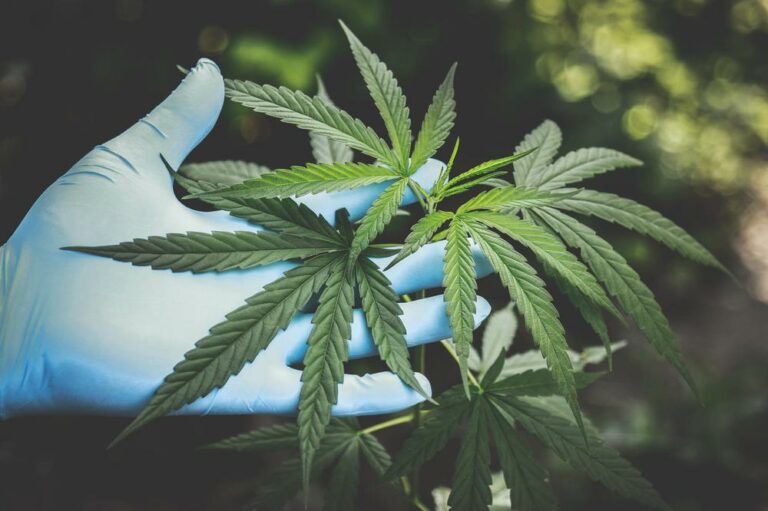 Can CBD Help With AVM?
Can CBD Help With AVM?
- Arteriovenous malformation (AVM) is a neurological disorder that may be complicated by epilepsy. The formation of lesions in the brain impairs the nerve conduction function and damages the brain structure(1).
- Cannabidiol (CBD) may help with seizures(2). However, AVM seizures are not the same type of seizures that CBD is approved to treat.
- The only CBD product approved by the US Food and Drug Administration (FDA) is Epidiolex, a CBD prescription drug used in treating two rare and severe forms of epilepsy(3).
- Besides seizures, other AVM symptoms include pain, backaches, and headaches. A study in 2006 noted that CBD, the nonpsychoactive component of cannabis plants, may help alleviate pain. Conditions include oncologic, inflammatory, and neuropathic pain(4).
- A study in 2018 found that CBD is well tolerated in humans. It is not addictive, and it has an excellent safety profile. Still, a consultation with a doctor is essential before trying CBD for AVM(5).
CBD for Managing AVM Symptoms
Some of the AVM symptoms include headaches, backaches, and pain. A study in 2006 noted that cannabidiol (CBD), the nonpsychoactive component of cannabis plants, helps alleviate pain. These conditions include neuropathic, inflammatory, and oncologic pain(6).
A study showed that CBD may help with seizures(7). AVM symptoms include seizures and the inability to coordinate movements(8).
However, AVM seizures are not the same type of seizures that CBD is approved to treat. Seizures are serious and require other immediate and more appropriate emergency medical treatments.
The only CBD product approved by the US Food and Drug Administration (FDA) is Epidiolex, a CBD prescription drug used in treating two rare and severe forms of epilepsy(9).
Even if the FDA does not approve CBD as a supplement, it does not mean that it is unsafe. A study in 2018 found that CBD is well tolerated in humans. It is not addictive, and it has an excellent safety profile(10).
The study also discussed the therapeutic benefits of CBD on various medical conditions, like seizure disorders, psychotic symptoms, anxiety, depression, inflammation, cancer, cardiovascular diseases, neurodegeneration, symptoms of multiple sclerosis, and chronic pain.
Another study conducted in 2012(11) outlined CBD’s potential role in treatments involving the heart and the peripheral and cerebral vasculature. CBD has anti-inflammatory and antioxidant properties that have positive effects on the body.
CBD may help protect the body against vascular damage, inflammation, and even type-2 diabetes. A study suggested that CBD may help increase blood flow in animal models of stroke(12).
While some studies were done on animals, CBD’s effectiveness may extend to humans. A study stated that humans and all animals except insects have an endocannabinoid system (ECS) that works the same way, regardless of species(13). The ECS is the system that regulates cannabinoid function.
Tetrahydrocannabinol (THC), CBD’s counterpart, also has therapeutic benefits. However, the substance may induce psychoactive effects or a high sensation. CBD, THC, and other cannabinoids exist within medical marijuana and hemp alike.
CBD has no standard dosage. It is recommended to begin with small doses, and if there are no adverse effects, patients may gradually increase their intake.
What Is Arteriovenous Malformation?
AVM is characterized by an abnormal tangle of blood vessels that causes irregular connections between the veins and arteries. When AVM happens, the amount of oxygen that reaches the neurological tissues is reduced(14).
AVM can occur anywhere in the body, often in the spinal cord or brain. Doctors tend to discover AVM incidentally when patients undergo treatment for an unrelated disorder or during an autopsy(15).
For instance, a 43-year-old male had a urinary tract infection. While antibiotics helped, his urinary ultrasound result pointed to a rare asymptomatic but renal arteriovenous malformation (RAVM)(16).
In another study, a 40-year-old woman with no external injuries died. Postmortem CT angiography confirmed cerebral arteriovenous malformation in her skull(17).
AVM occurs before birth or shortly after. However, what causes AVM remains unknown(18).
AVMs can form anywhere in the body. They could happen in the stomach and affect other areas, such as the duodenum.
A 69-year-old man with gastrointestinal bleeding was diagnosed with AVM in the small intestine. However, the doctors discovered the AVM only when they performed a small bowel endoscopy on the patient(19).
Symptoms of AVM
Symptoms of AVM vary and depend on where they are located. The most common symptoms include(20):
- Headache
- Seizures
- Nausea and vomiting
- Progressive loss of neurological function in the affected area
- Loss of consciousness
- Weak muscles
- Dizziness
- Back pain
- Weakness in the lower extremities
- Inability to coordinate movements that cause an unsteady gait
- Vision problems, including swelling of part of the optic nerve, loss of control of eye movements, and losing part of the field of vision
- Confusion
- Dementia or memory loss
- Problems with understanding language or speech
- Bleeding
One type of AVM called vein of Galen malformation (VGAM or VOGM) is often detected on prenatal ultrasounds(21). It typically presents with symptoms, such as
- Congestive heart failure
- Tachypnea (increased respiration)
- Respiratory distress
- Cyanosis (bluish discoloration in the hands or feet due to low oxygen)
- Hydrocephalus
- Drooping eyes
Symptoms of AVM usually emerge at a young age. In some cases, symptoms appear only in older age. The condition tends to be clinically asymptomatic(22).
Spinal AVMs can have similar symptoms as that of multiple sclerosis. However, advances in neuroscience and MRI helped differentiate the two conditions(23).
Individuals with AVMs should be concerned about hemorrhage (uncontrolled bleeding). Although less than 4% of AVMs hemorrhage, excessive bleeding can be severe and even fatal(24).
In a study, a 31-year-old laboring patient did not know she had an AVM until her emergent cesarean delivery(25).
When the surgical incision was closed, a CT examination and angiogram (X-ray of the blood vessels) were performed. A ruptured AVM was discovered and a cerebral artery aneurysm was ruled out.
Authors of the same study discussed that if a subarachnoid hemorrhage — bleeding in the space surrounding the brain — was not immediately treated, rapid brain displacement may lead to death(26).
An AVM accounts for about 2% of all hemorrhagic strokes every year. It also causes hemorrhage in kids and young adults(27).
However, note that confusion exists in the terminology of a vascular anomaly in infants. Hemangioma is not a vascular malformation, unlike AVM(28).
Other types of vascular lesions that may affect the central nervous system are venous malformations, capillary telangiectasia, and cavernous malformations. These lesions do not pose the same risk of hemorrhage(29).

Treatment of AVM
The most definitive but invasive treatment for AVM is surgery, whereas medications can help treat symptoms. Surgery is often used when the AVM is in an area where surgeons can remove it or when the patient is at high risk of bleeding(30).
The most common ways to manage AVM is through surgical embolization and sclerotherapy.
Embolization involves putting materials like medical glue, metal coils, and plugs into the center of the AVM. These block the AVM and prevent blood from flowing into it, thereby helping in shrinking the AVM.
Meanwhile, sclerotherapy happens when a sclerosant (liquid medicine) is injected into the AVM to destroy the vessels and cause less blood flow to the AVM or none at all(31).
Each patient recovers at a different pace. They may be able to do their usual activities four to six weeks after the surgery. However, they may need about two to six months to recover fully(32).
Torstein R. Meling, MD, DPhil, FEBNS, IFAANS, says brain surgery for AVM is still “a work in progress.” There are surgical risks linked to treating BAVM (brain AVM)(33).
A study from the University of Edinburgh concurs with that of Dr. Meling. “We have found that, for most people whose AVM has not caused a bleed, the risks of treatment exceed the risks of leaving it alone over 12 years,” Medical Research Council Senior Clinical Fellow Professor Rustam Al-Shahi Salman said(34).
For the past years, Professor Salman’s studies expanded beyond intracranial hemorrhage and stroke.
Research published in the Journal of Neurology, Neurosurgery & Psychiatry stated that a multidisciplinary team should perform the brain AVM treatment. It should be composed of a neurosurgeon, neurologist, neuroradiologist, and radiotherapist(35).
Four out of 100 people with AVM may bleed. Of those four, there is a 90% chance of surviving from the hemorrhage. Determining who may bleed and those who may not depend on several factors. These include how the lesion drains from the brain and the location of AVM(36).
Conclusion
An AVM is usually benign. However, if it results in bleeding, it can lead to serious neurological problems. It has no one-size-fits-all treatment yet, so experts can only help manage symptoms.
CBD has many therapeutic benefits that may help alleviate the symptoms of AVM. CBD may also help treat the causes of sleep problems.
Patients are encouraged to inform their doctors before taking CBD, such as CBD oil, for any reason. Never attempt to self-diagnose or self-treat.
- Mao, K., You, C., Lei, D., & Zhang, H. (2015). High dosage of cannabidiol (CBD) alleviates pentylenetetrazole-induced epilepsy in rats by exerting an anticonvulsive effect. International journal of clinical and experimental medicine, 8(6), 8820–8827.
- Silvestro, S., Mammana, S., Cavalli, E., Bramanti, P., & Mazzon, E. (2019). Use of Cannabidiol in the Treatment of Epilepsy: Efficacy and Security in Clinical Trials. Molecules (Basel, Switzerland), 24(8), 1459. https://doi.org/10.3390/molecules24081459
- Commissioner, Office of the. “What to Know About Products Containing Cannabis and CBD.” U.S. Food and Drug Administration, FDA, www.fda.gov/consumers/consumer-updates/what-you-need-know-and-what-were-working-find-out-about-products-containing-cannabis-or-cannabis.
- Manzanares, J, et al. “Role of the Cannabinoid System in Pain Control and Therapeutic Implications for the Management of Acute and Chronic Pain Episodes.” Current Neuropharmacology, Bentham Science Publishers Ltd., 4 July 2006, www.ncbi.nlm.nih.gov/pmc/articles/PMC2430692/.
- R Al-Shahi, C Warlow. Arteriovenous malformations of the brain: ready to randomise? , Journal of Neurology, Neurosurgery & Psychiatry, https://jnnp.bmj.com/content/76/10/1327
- Manzanares, J, et al. “Role of the Cannabinoid System in Pain Control and Therapeutic Implications for the Management of Acute and Chronic Pain Episodes.” Current Neuropharmacology, Bentham Science Publishers Ltd., 4 July 2006, www.ncbi.nlm.nih.gov/pmc/articles/PMC2430692/.
- Perucca E. (2017). Cannabinoids in the Treatment of Epilepsy: Hard Evidence at Last?. Journal of epilepsy research, 7(2), 61–76. https://doi.org/10.14581/jer.17012
- Mayo Clinic. Brain AVM (arteriovenous malformation), https://www.mayoclinic.org/diseases-conditions/brain-avm/symptoms-causes/syc-20350260
- What to Know About Products Containing Cannabis and CBD. op. cit.
- Corroon. op. cit.
- Stanley, Christopher P et al. “Is the cardiovascular system a therapeutic target for cannabidiol?.” British journal of clinical pharmacology vol. 75,2 (2013): 313-22. doi:10.1111/j.1365-2125.2012.04351.x
- Ibid.
- Silver, Robert J. “The Endocannabinoid System of Animals.” Animals : an open access journal from MDPI vol. 9,9 686. 16 Sep. 2019, doi:10.3390/ani9090686
- “Arteriovenous Malformation Information Page.” National Institute of Neurological Disorders and Stroke, https://www.ninds.nih.gov/Disorders/All-Disorders/Arteriovenous-Malformation-Information-Page#:~:text=of%20these%20lesions.-,An%20NINDS%20study%20at%20Columbia%20University%2C%20A%20Randomized%20Trial%20of,between%20the%20arteries%20and%20veins.
- Ibid.
- Barbara Hermans et al, (2017). Incidentally Detected Renal Arteriovenous Malformation: A Case Report and Review of the Literature, https://www.emjreviews.com/urology/article/incidentally-detected-renal-arteriovenous-malformation-a-case-report-and-review-of-the-literature/
- Arteriovenous malformation | Mayo Clinic, https://www.mayoclinic.org/diseases-conditions/arteriovenous-malformation/symptoms-causes/syc-20350544
- Ibid.
- Fujii, Takaaki, et al. “Arteriovenous Malformation Detected by Small Bowel Endoscopy.” Case Reports in Gastroenterology, S. Karger AG, 17 Oct. 2014, www.ncbi.nlm.nih.gov/pmc/articles/PMC4241646/.
- Qian, H., Shao, Y., Li, Z., Huang, P., Zou, D., Liu, N., Chen, Y., & Wan, L. (2016). Diagnosis of a Cerebral Arteriovenous Malformation Using Isolated Brain Computed Tomography Angiography: Case Report. The American journal of forensic medicine and pathology, 37(3), 201–204. https://doi.org/10.1097/PAF.0000000000000247
- Vein of Galen Malformation. UCLA Interventional Neuroradiology, https://www.uclahealth.org/radiology/interventional-neuroradiology/vein-of-galen-malformation
- Arteriovenous malformation | Mayo Clinic, https://www.mayoclinic.org/diseases-conditions/arteriovenous-malformation/symptoms-causes/syc-20350544
- L. Radolović Prenc et al (2012) Concurrence of multiple sclerosis and vascular malformation of the brainstem: case report. Neurol. Croat, https://www.neurologiacroatica.com/en/pdf/03_04_neuro_2012_3.pdf
- Arteriovenous Malformations and Other Vascular Lesions of the Central Nervous System Fact Sheet. National Institute of Neurological Disorders and Stroke, https://www.ninds.nih.gov/Disorders/Patient-Caregiver-Education/Fact-Sheets/Arteriovenous-Malformation-Fact-Sheet
- Bürki M, Kappeler L, Bühler R, Springe D, Ebnöther L, Delgado M. (2018). Massive Arteriovenous Malformation with Stroke-Like Presentation. Case Rep Neurology, https://www.karger.com/Article/FullText/494466#
- Bokhari MR, Bokhari SRA. (2020). Arteriovenous Malformation Of The Brain, https://www.ncbi.nlm.nih.gov/books/NBK430744/
- English, L. A., & Mulvey, D. C. (2004). Ruptured arteriovenous malformation and subarachnoid hemorrhage during emergent cesarean delivery: a case report. AANA Journal, https://www.aana.com/docs/default-source/aana-journal-web-documents-1/423-426.pdf?sfvrsn=a3f055b1_6
- “Arteriovenous Malformations.” Arteriovenous Malformations | Johns Hopkins Medicine, www.hopkinsmedicine.org/health/conditions-and-diseases/arteriovenous-malformations
- English, L. A. op. cit.
- Mayo Clinic. op. cit
- “Arteriovenous Malformation Repair: What to Expect at Home.” MyHealth.Alberta.ca, https://myhealth.alberta.ca/Health/aftercareinformation/pages/conditions.aspx?hwid=zc2754#:~:text=Medicine%20and%20ice%20packs%20can,6%20months%20to%20fully%20recover.
- John Hopkins Medicine. op. cit.
- Meling, T.R. (2017). To treat or not to treat brain AVMs—that’s still the question. Acta Neurochir. https://doi.org/10.1007/s00701-017-3219-8
- “Brain Blood Vessel Disorder Best Left Alone.” The University of Edinburgh, 24 June 2015, www.ed.ac.uk/medicine-vet-medicine/news-events/news-archive/news-2014/avm-290414
- R Al-Shahi. op. cit.
- Stanley, Christopher P et al. “Is the cardiovascular system a therapeutic target for cannabidiol?.” British journal of clinical pharmacology vol. 75,2 (2013): 313-22. doi:10.1111/j.1365-2125.2012.04351.x












